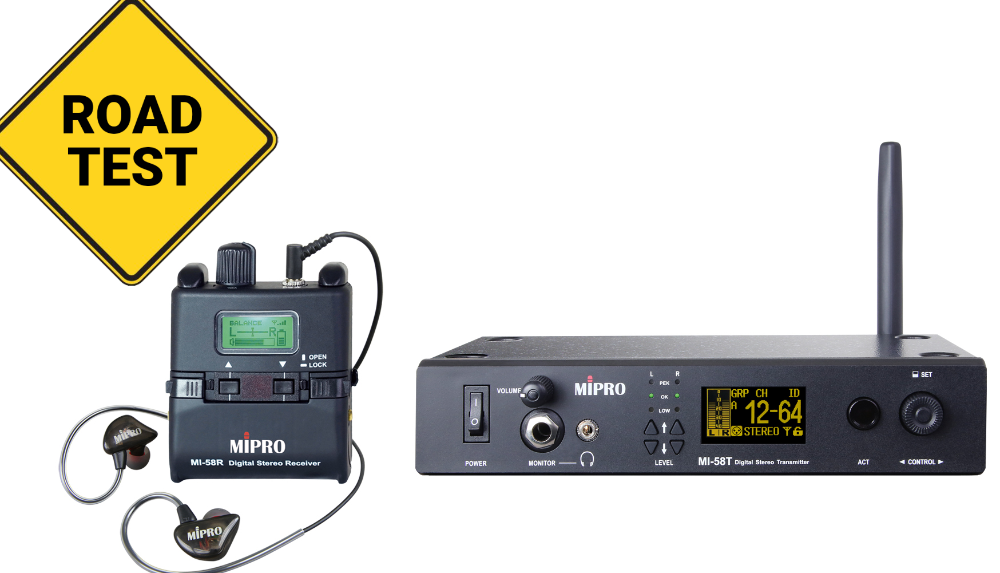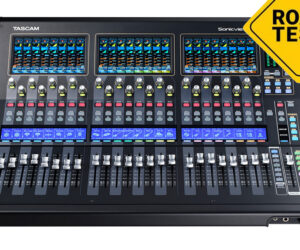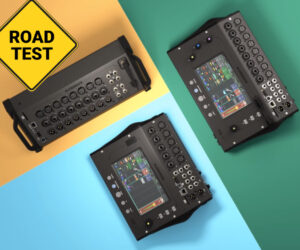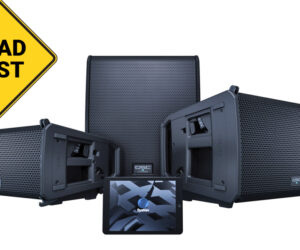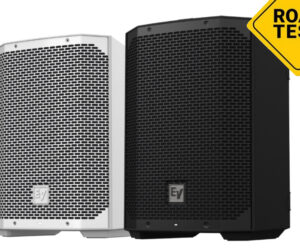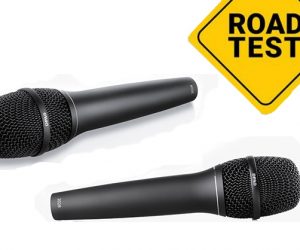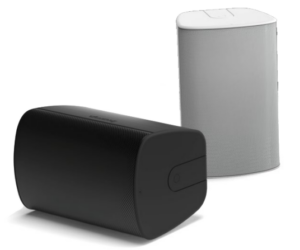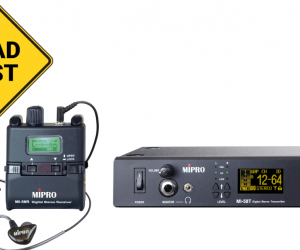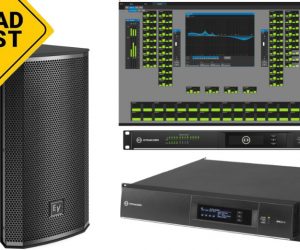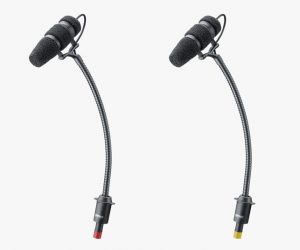The MIPRO MI-58 is a stereo digital in-ear wireless monitor system consisting of the MI-58R beltpack receiver and the MI-58T or MI-58TD transmitter. Why two different transmitters? The “TD” version interfaces with Audinate Dante audio networks.
The MI-58 operates in the ISM 5.8 GHz frequency band and offers three frequency groups (A, B1 and B2) with 12 channels in group A and 24 channels in groups B1 and B2 to choose from. The digital system uses a 24-bit/48 kHz sampling rate and has very low stated latency of 2.2 milliseconds.

The transmitter (base) unit comes in a half-rack size and can be rack-mounted singly or with two units next to each other with the optional FB-71 or FB-72 rack mount kits. Also optionally supplied are FBC-72 cables to relocate the antenna from the back of the unit to the front when rack mounting.
The stated frequency response range of the system is an impressive 20 Hz to 23 kHz, with the transmitter offering 25 mW output power. The front panel is equipped with an OLED graphical screen, push and turn rotary selector knob, push to sync button and stereo level button plus meters to set the volume. A power switch and two headphone jacks (both 1/4-inch TRS and 3.5-mm TRS) with volume control complete the front panel controls.
The rear of the transmitter offers XLR/TRS combo inputs, 1/4-inch TRS loop outputs, antenna connector, power connection for the 12-volt “wall wart” power supply, RJ-11 connectors for the ACT-BUS networking interface, and an RJ-45 connection for Dante output (again, for the TD version). The transmitter is well built and comes in a sturdy metal body.
The beltpack receiver has to be one the smallest units in the industry and is housed in a lightweight glass-fiber reinforced plastic case. It sports a combination on/off volume control, a 3.5 mm earphone jack, a backlit LED display, and up and down push buttons.
Opening up the battery compartment provides access to a mode push button as well as the Lithium-ion rechargeable battery (ICR18500). The beltpack has stated stereo separation of >100 dB and output of 100 mW (both left/right) at 16 ohms. MIPRO’s E-8S standard earphones are included. Optional accessories include the drop in MP-8 single charger, MP80 dual charger, and E-8P professional earphones. An AT-58 directional antenna is expected to be released soon.
Getting Acquainted
The first thing I noticed when I was unpacking the box was that the system ships with a quality plastic foam-lined carry case, perfect for gigging performers who are not going to rack mount the transmitter. I also noticed the transmitter’s aforementioned 1/4-inch and 3.5-mm jacks – nice! I’m always misplacing my 3.5 mm-to-1/4-inch headphone adapter on gigs, and this smart design consideration solves that problem.
The next thing that stood out is just how compact stature and light weight of the beltpack receiver. It also sports a wire spring clip, making it easy to attach to clothing or belts.
As with all gear evaluations I do, the first stop was my test bench in the shop for inspection and a brief test run. Hooking up the transmitter was easy in using the combo jacks for the input. While I own a few earphones, MIPRO also sent along a set of its E-8S standard earphones. They were supplied in beige and can be fitted with any of the three earbud covers so users can attain the preferred fit, and in another nice touch, they’re joined by a long cord.
In addition, the company provided an MP-8 charger so that I could charge the receiver’s battery. While I was waiting for the battery to be topped off, I plugged the earphones into my phone for a listen before using them with the system. They sound quite good and are very comfortable to wear.

After about a half hour of charging, I hooked up the rig to my bench mixer. It was easy to set the levels to the transmitter by using the front panel gain controls and meters. I plugged the earphones into the beltpack, picked a channel, and was in business. The sonic quality of the system is impressive.
Next, I decided to test the working range of the rig by walking around my warehouse, putting metal pallet racking and shelving in between the transmitter and receiver, and didn’t experience a single glitch or dropout. Determined to make the unit “hiccup,” I walked outside the shop, and even with a metal door and about 100 feet in between the transmitter and receiver, there were no noticeable problems.
One feature I really like about the system is that if you feed the transmitter a stereo signal, you can set the beltpack to a “MIXED” setting and get both left and right signal in each ear. Satisfied that all was working correctly and that nothing had been damaged in shipping, I headed out to a few gigs.
Out In The World
A friend had a family emergency and asked if I could fill in at his church for a youth band rehearsal. Since the band was used to floor monitors and none of the performers had ever used IEMs, I set up the system as my own mobile monitor. I plugged the headphone jack of the digital console into the transmitter and could hear the main mix.
But, more importantly, when used with the mixer’s app on my iPad, I could hit “solo” when I wanted to listen to a particular instrument – and that’s what I heard in my ear. I say “ear” because as I was walking around mixing, I inserted only a single ear bud.
The system performed flawlessly, and the setup allowed me to walk around with my iPad and mix remotely from the digital console but still be able to solo a channel or output. I also tried my headphones with the receiver while walking around, so if a user is dealing with a very loud band or a noisy environment, they have the option to wear headphones instead of the ear buds. The beltpack had more than enough volume to power up the headphones there were dropouts or other problems.

Next up was a Mother’s Day affair at the same church, and at sound check, I asked one of the praise band singers who had her own IEM system if we could substitute it with the MI-58. She happily complied, using her own custom molded earphones. After sound check she approached me and commented how small and light the beltpack was compared to her own. After the performance, she again complimented the miniscule size and weight of the pack in addition to noting the sonic quality of the system.
Before the evaluation process of the MI-58, I was already a big fan of MIPRO, but after doing a bit of research I learned of the pricing and now I’m even more impressed. The unit sounds great, works very well and has a ton of features at a price point that are below many other comparable systems.
Further, having a Dante networking capability is increasingly valuable, and I can see many productions jumping at the chance to network their IEMs because now it’s now affordable. Finally, there are a lot of channels to choose from and the signal was absolutely rock-solid throughout the testing process. As a result, I think MIPRO has a real winner on its hands with the MI-58 system.
Find out more about the MIPRO MI-58 here.
U.S. MSRP: $670, U.S. MAP: $497 (Non-Dante version with charging cradle and earbuds); U.S MSRP: $835, U.S. MAP: $597 (Dante version with charging cradle and earbuds).


